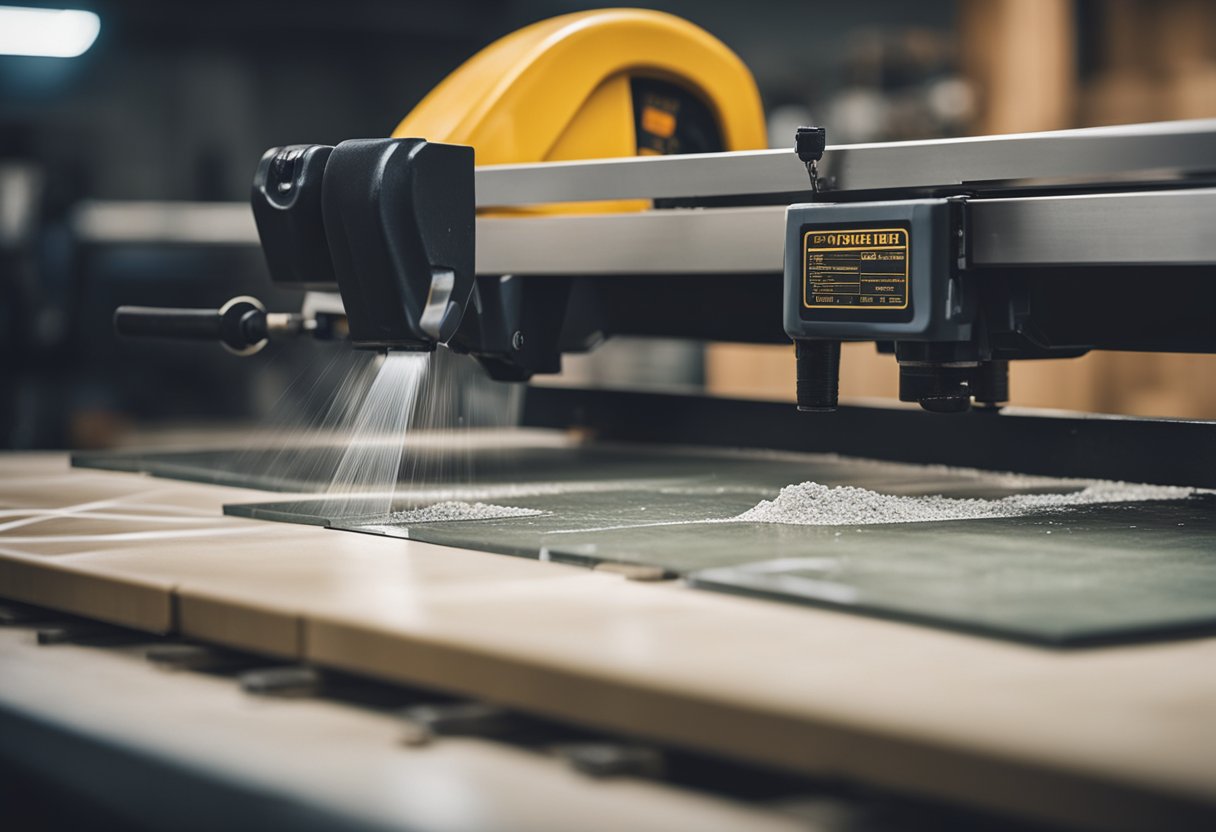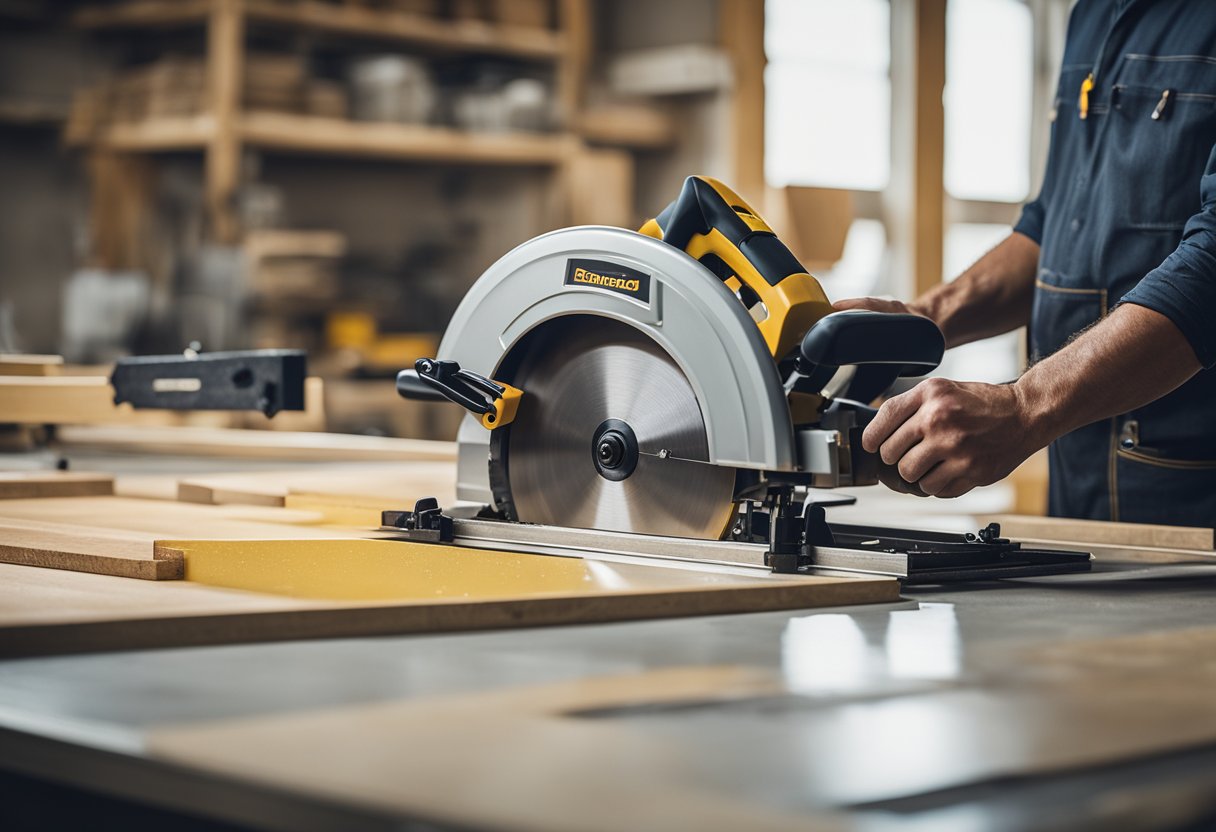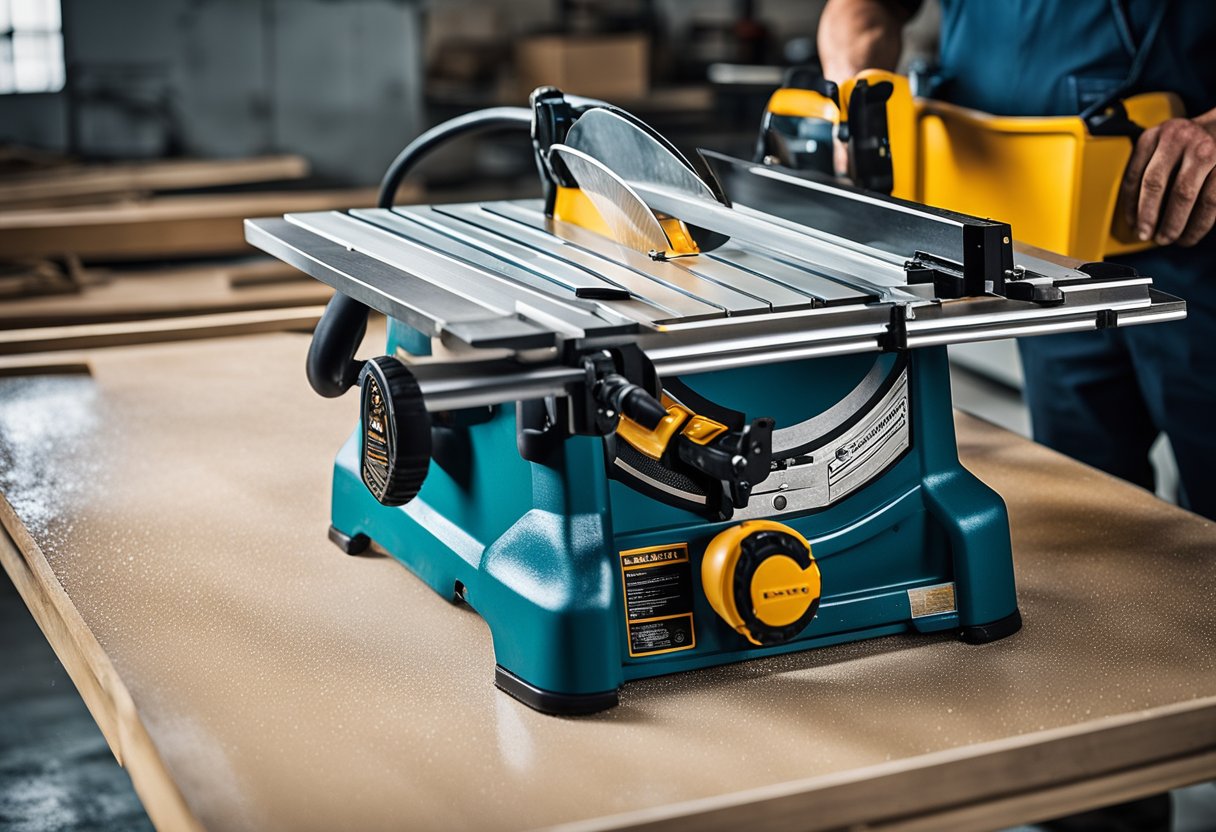I have researched whether it is possible to cut tiles with a table saw, and the answer is yes, but it is not recommended. While a table saw can be used to cut ceramic and stone tiles, using a dry blade will create more chips in the tile than using a wet saw. Additionally, cutting tiles with a table saw can produce a lot of dust, which can be harmful to your health.
If you don’t have a tile cutting saw, using a table saw may be your only option. However, it is important to use the proper tools and safety measures when cutting tiles with a table saw. This includes using a diamond blade, wearing protective gear, and cutting the tiles slowly and carefully.
Key Takeaways
- Cutting tiles with a table saw is possible, but not recommended due to the potential for chipping and dust production.
- Proper tools and safety measures are essential when cutting tiles with a table saw.
- If possible, it is best to use a wet saw for cutting tiles.
Understanding Tile and Table Saw
When it comes to cutting tiles, there are a few things to keep in mind. Tiles can be made from various materials such as ceramic, stone, glass, porcelain, natural stone, and slate tiles. Each of these materials has its own unique properties, which determine the best way to cut them.
A table saw is a versatile tool that can be used for cutting different types of materials. However, it is not recommended to use a table saw for cutting tiles unless you have the right blade and take the necessary safety precautions.
Ceramic tiles are one of the most popular types of tiles used in homes and offices. They are durable, easy to clean, and come in a variety of colors and patterns. However, cutting ceramic tiles with a table saw can be challenging. Ceramic tiles are brittle and can crack easily, which can lead to inaccurate cuts.
Stone tiles, on the other hand, are more durable than ceramic tiles and are commonly used for flooring and countertops. Cutting stone tiles with a table saw requires a diamond blade and water to prevent the blade from overheating.
Glass tiles are also becoming popular in modern home design. They are delicate and require a specific type of blade to cut them without chipping or cracking.
Porcelain tiles are similar to ceramic tiles but are denser and more durable. They are often used in high-traffic areas such as kitchens and bathrooms.
Natural stone tiles, such as marble and granite, are beautiful and durable. However, they are more challenging to cut than other types of tiles and require a specialized blade.
Slate tiles are known for their natural beauty and unique texture. They are commonly used for flooring and roofing. Cutting slate tiles with a table saw requires a diamond blade and water to prevent cracking and chipping.
In summary, while it is possible to cut tiles with a table saw, it is not always the best option. The type of tile you are cutting will determine the type of blade you need and the safety precautions you should take. It is always best to consult an expert or follow the manufacturer’s instructions before attempting to cut tiles with a table saw.
Essential Tools for Cutting Tile with a Table Saw
When it comes to cutting tiles with a table saw, there are a few essential tools that you will need to ensure a successful and safe project.
Table Saw
First and foremost, you will need a table saw. A table saw is a power tool that consists of a circular saw blade, mounted on an arbor, that is driven by an electric motor. Table saws are available in a variety of sizes and styles, but for cutting tiles, a larger table saw with a powerful motor is recommended.
Diamond Blade
To cut tiles with a table saw, you will need a diamond blade. Diamond blades are specifically designed for cutting hard materials such as tiles and stones. These blades have diamond grit embedded in the rim of the blade, which allows them to cut through the hard surface of the tile with ease. Diamond blades are available in a range of sizes and styles, so it’s important to choose the right blade for your project.
Wet Saw
While it is possible to cut tiles with a dry blade on a table saw, it is not recommended. Dry blades create more chips in the tile and can be hazardous to your health due to the dust created. Instead, it is recommended to use a wet saw. Wet saws use water to cool the blade and reduce the amount of dust created. This makes them a safer and more efficient option for cutting tiles.
Dust Collection
Regardless of whether you use a dry or wet blade, it’s important to have proper dust collection in place. The dust created by cutting tiles can be hazardous to your health, so it’s important to wear a mask and have a dust collection system in place. This will help to reduce the amount of dust in the air and keep you safe while you work.
Handheld Tile Saws
In addition to table saws, handheld tile saws are another option for cutting tiles. These saws are smaller and more portable than table saws, making them a good option for smaller projects or for cutting tiles in hard-to-reach areas. Handheld tile saws are available with both dry and wet blades, so it’s important to choose the right option for your project.
In conclusion, cutting tiles with a table saw requires a few essential tools, including a table saw, diamond blade, wet saw, dust collection, and handheld tile saws. By using the right tools and taking the necessary safety precautions, you can successfully cut tiles with a table saw and achieve professional-looking results.
Safety Measures When Cutting Tiles
When cutting tiles with a table saw, safety should be your top priority. Here are some safety measures you should take to ensure that you are safe while cutting tiles:
Wear Safety Gear
Before you start cutting tiles, you should put on safety gear to protect yourself. Safety gear includes safety goggles, gloves, and a respirator. Safety goggles will protect your eyes from flying debris, while gloves will protect your hands from sharp edges. A respirator will protect your lungs from dust and other particles that can be harmful.
Keep Your Work Area Clean
Keeping your work area clean is essential when cutting tiles. Dust and debris can accumulate quickly and make it difficult to see what you are doing. You should clean up any debris as soon as possible to avoid accidents.
Use the Right Blade
Using the right blade is crucial when cutting tiles. You should use a diamond blade designed for cutting tiles. Using the wrong blade can cause the tile to crack or break, which can be dangerous.
Keep Your Hands Away from the Blade
When cutting tiles, you should keep your hands away from the blade at all times. Use a push stick to guide the tile through the blade. This will keep your hands a safe distance away from the blade and prevent accidents.
Turn off the Saw When Not in Use
When you are not using the saw, you should turn it off. This will prevent accidents and ensure that you are safe when you are not cutting tiles.
Conclusion
By following these safety measures, you can ensure that you are safe when cutting tiles with a table saw. Remember to wear safety gear, keep your work area clean, use the right blade, keep your hands away from the blade, and turn off the saw when not in use.
Preparation Process for Cutting Tiles
https://www.youtube.com/watch?v=T6ScCz8Gb_o&embed=true
Before cutting tiles with a table saw, I need to prepare the workspace and gather the necessary tools. The tools required for cutting tiles include a table saw, a diamond or carbide saw blade, a straightedge, a pencil, and a tile file or rubbing stone. Here is a step-by-step guide to prepare for cutting tiles with a table saw.
-
Measure the tile: To cut the tile accurately, I need to measure the length and width of the tile. I can use a tape measure to measure the tile’s dimensions.
-
Mark the cutting line: After measuring the tile, I need to mark the cutting line on the tile’s surface. I can use a pencil to draw a straight line along the tile’s surface.
-
Secure the tile: To prevent the tile from moving while cutting, I need to secure it to the table saw. I can use clamps to hold the tile in place.
-
Install the saw blade: I need to install a diamond or carbide saw blade on the table saw. I should ensure that the blade is the appropriate size for the tile.
-
Adjust the saw blade: I need to adjust the saw blade’s height to match the tile’s thickness. I can adjust the blade height using the table saw’s adjustment knob.
-
Cut the tile: After securing the tile and adjusting the saw blade, I can start cutting the tile. I should turn on the saw and slowly push the tile through the blade, making sure to keep my hands away from the blade.
-
File the edges: After cutting the tile, I should file the edges using a tile file or rubbing stone. This will help smooth out the edges and prevent any sharp edges from injuring someone.
By following these steps, I can prepare for cutting tiles with a table saw.
Step-by-Step Guide to Cutting Tiles
https://www.youtube.com/watch?v=Scl702kun1o&embed=true
Cutting tiles can be a daunting task, but with the right tools and techniques, it can be done with ease. In this guide, I will walk you through the steps to cut tiles using a table saw.
Required Tools
To cut tiles with a table saw, you will need the following tools:
- Table saw
- Tile blade
- Push stick
- Fence
Preparation
Before you start cutting tiles, make sure to wear protective gear such as gloves, goggles, and a dust mask. It is also important to prepare your workspace by clearing any clutter and ensuring that the table saw is stable.
Making Straight Cuts
To make straight cuts, measure the tile you want to cut with a straight edge and mark the line with a pencil. You can use a grease pencil that can draw on difficult surfaces like tile. Then, set the fence on the table saw to the desired width and adjust the blade height accordingly. Using a push stick, guide the tile through the blade, applying steady pressure.
Making Precise Cuts
For more precise cuts, you can use a miter gauge to guide the tile through the blade. This will ensure that the tile is cut at the desired angle. When making precise cuts, it is important to take your time and apply even pressure to avoid chipping.
Making Curved Cuts
To make curved cuts, you will need to use a tile blade with a smaller diameter. Set the blade height to the desired depth and adjust the fence accordingly. Using a push stick, guide the tile through the blade, applying steady pressure. It is important to take your time and make small, gradual cuts to avoid cracking the tile.
Conclusion
Cutting tiles with a table saw can be a quick and efficient way to get the job done. By following these simple steps and taking your time, you can achieve precise cuts with ease.
Dealing with Different Types of Tiles
When it comes to cutting tiles with a table saw, it’s important to understand that different types of tiles require different blades and techniques. Here’s what you need to know:
Ceramic Tile
Ceramic tile is the most common type of tile used in home improvement projects. It’s also one of the easiest to cut with a table saw. A standard carbide blade is usually sufficient for cutting ceramic tile. However, it’s important to note that the dry blade used with a table saw will create more chips in the tile than if you used a wet saw. Additionally, the hazardous dust created by slicing into a ceramic tile can cause serious damage to your table saw. Therefore, it’s important to wear a dust mask and eye protection while cutting ceramic tile with a table saw.
Glass Tile
Glass tile is a bit trickier to cut than ceramic tile. A diamond blade is required to cut glass tile, which can be expensive. It’s also important to note that the cuts may not be as precise or attractive as with other tools. To avoid chipping or cracking the glass tile, it’s recommended to use a wet saw or a tile cutter specifically designed for glass tile.
Stone Tile
Stone tile, such as granite or marble, requires a diamond blade to cut. These blades are more expensive than standard carbide blades, but they’re necessary for cutting through the tough stone material. It’s also important to use a wet saw when cutting stone tile to prevent overheating and cracking.
Cut Tiles
When cutting tiles with a table saw, it’s important to measure and mark the tile before cutting. To measure where the tile needs to be cut, place a tile on top of the last full tile, and mark with a pencil where the overlap is. Make sure you leave enough room for the grout joint and movement joint. Movement joints must not be grouted, the use of a sealant would be recommended.
Cleaning and Maintenance After Cutting Tiles
After cutting tiles with a table saw, it is essential to clean up the dust and debris left behind. The dust created by slicing into a ceramic tile can cause serious damage to your table saw, so it is important to clean it up properly. I recommend using a dust mask to protect yourself from inhaling any harmful dust particles.
To clean up the dust, I suggest using a shop vacuum or a dust collection system. This will help you to collect the dust and debris more efficiently. Be sure to clean the table saw thoroughly, including the blade, the blade guard, and the table itself. You can use a soft brush or a cloth to clean the dust off of the blade and blade guard.
It is also important to inspect the blade after cutting tiles. The blade can become dull or damaged after cutting through hard materials like tiles. If you notice any damage or dullness, it is time to replace the blade. A dull or damaged blade can cause uneven cuts and can be dangerous to use.
When you are finished cleaning up, store your table saw in a dry and safe place. If you are using your table saw at home, make sure it is stored in a place where children cannot access it.
In conclusion, cleaning and maintenance are essential after cutting tiles with a table saw. By following these simple steps, you can ensure that your table saw stays in good condition and that you are safe while using it.
Alternatives to Cutting Tile with a Table Saw
https://www.youtube.com/watch?v=ZgNasC4hirI&embed=true
When it comes to cutting tiles, a table saw is not the only option available. In fact, there are several other tools that can cut tiles with ease. Here are some of the most popular alternatives to cutting tile with a table saw:
Wet Saws
Wet saws are specifically designed for cutting tiles. They use a water source to keep the tile cool and lubricated while cutting. This helps to prevent the tile from cracking or chipping during the cutting process. Wet saws are available in both handheld and stationary models, making them a versatile choice for any tile cutting project.
Tile Cutters
Tile cutters are another popular option for cutting tiles. These manual tools use a sharp blade to score the tile before snapping it along the scored line. Tile cutters are available in both handheld and tabletop models, making them a great choice for both small and large tile cutting projects.
Angle Grinders
Angle grinders are a versatile tool that can be used for a variety of cutting tasks, including cutting tiles. With the right blade, an angle grinder can easily cut through ceramic, porcelain, and other types of tiles. However, it’s important to note that angle grinders can generate a lot of dust, so proper safety precautions should be taken when using them.
Glass Cutters
Glass cutters can also be used to cut tiles. These tools use a small, sharp wheel to score the tile before breaking it along the scored line. While glass cutters can be used on a variety of tile types, they are best suited for cutting small tiles or making intricate cuts.
Nippers
Nippers are a handheld tool that can be used to make small cuts or trim tiles. These tools use a sharp, biting action to cut through the tile. While nippers are not ideal for making long cuts or cutting large tiles, they are a great choice for trimming tiles to fit around corners or other obstacles.
Overall, there are several alternatives to cutting tile with a table saw. Whether you choose a wet saw, tile cutter, angle grinder, glass cutter, nippers, or another tool, it’s important to choose the right tool for the job to ensure a clean, accurate cut.
Practical Applications of Cut Tiles
Cut tiles can be used in a variety of practical applications, making them a versatile material for DIY projects. Whether you are looking to create a backsplash for your kitchen or bathroom, or to cover walls in an irregular shape, cut tiles can provide a durable and attractive solution.
One of the advantages of using cut tiles is their versatility. They can be cut to fit any size or shape, making them ideal for covering irregular surfaces. This means that you can create a unique design that suits your individual style and taste.
When it comes to DIY projects, cut tiles are a popular choice. They are readily available at home improvement stores like Home Depot, and can be cut to size using a table saw. This makes them a cost-effective option for those looking to take on a home renovation project.
Cut tiles can also be used to create a backsplash in your kitchen or bathroom. This not only adds a decorative element to the room, but also protects the walls from moisture and stains. The durability of cut tiles means that they can withstand the wear and tear of everyday use, making them a practical choice for high-traffic areas.
In conclusion, cut tiles are a versatile and practical material that can be used in a variety of DIY projects. Their durability and versatility make them an attractive option for those looking to create a unique design for their home. Whether you are looking to create a backsplash or cover an irregular surface, cut tiles can provide a cost-effective and attractive solution.
Frequently Asked Questions
https://www.youtube.com/watch?v=eEWu4xcHiGY&embed=true
What is the best tool to cut tile?
The best tool to cut tile depends on the type of tile you are working with. A manual tile cutter is best for cutting ceramic tiles and porcelain tiles, while a wet tile saw is best for cutting natural stone tiles and large format tiles. A wet tile saw allows for more precise cuts and reduces the risk of tile breakage.
Is a wet tile saw necessary to cut tile?
A wet tile saw is not always necessary to cut tile, but it is recommended for certain types of tiles, such as natural stone tiles and large format tiles. A wet tile saw uses water to cool the blade and reduce dust, which makes it easier to make precise cuts without damaging the tile.
Can a table saw be used to cut tile?
Yes, a table saw can be used to cut tile, but it is important to use a diamond blade specifically designed for cutting tile. It is also important to take safety precautions, such as wearing protective eyewear and a respirator to avoid inhaling dust.
What is the difference between a manual tile cutter and a wet tile saw?
A manual tile cutter is a handheld tool that scores and snaps the tile, while a wet tile saw uses a diamond blade and water to make precise cuts. A manual tile cutter is best for small jobs and cutting ceramic and porcelain tiles, while a wet tile saw is best for cutting natural stone tiles and large format tiles.
Can you rent a tile cutter from Home Depot or Lowe’s?
Yes, both Home Depot and Lowe’s offer tile cutter rentals. The rental options include manual tile cutters and wet tile saws.
Do I need a special diamond blade to cut tile with a table saw?
Yes, it is important to use a diamond blade specifically designed for cutting tile when using a table saw to cut tile. The diamond blade is designed to cut through the hard surface of the tile without damaging it.

Hi, I’m Sal Muller of Tooltrip.com. My DIY experience led me to understand essential power tools for home projects. Tooltrip.com guides enthusiasts and professionals in choosing right tools for any job. I provide concise top tool reviews for easier, efficient DIY.








